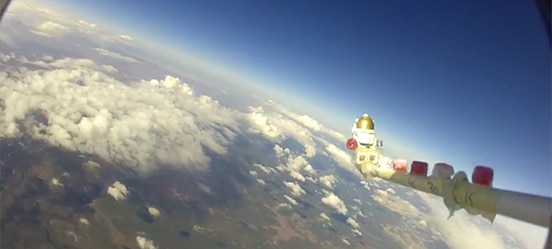We would like to start off by introducing a very influential person. One of our very own Golden Apple teachers, Kaci Heins, was awarded The Air Force Association’s 2014 National Teacher of the Year. According to AFA News, this award recognizes “classroom teachers at the national level for their achievements in building enthusiasm among K-12 students about science, technology, engineering and math (STEM), and preparing them to use these skills and contribute to tomorrow’s technologies.” Wind turbine design, solar ovens, plant growth chambers and high altitude ballooning are just a few of the engineering projects Heins made available to her students and community.
StratoStar recently had the opportunity to ask Heins some questions about her philosophy on STEM education and how StratoStar helps achieve her STEM program goals. We wanted to share some of her answers with you.
What is the philosophy behind project-based STEM education?
Heins said she works hard to complement the subject students are learning in the classroom with real-world, hands-on experiments. She believes this philosophy builds enthusiasm amongst the students and creates interest in STEM fields. Heins has concern with the lack of interest in STEM of future generations and is working to correct this. “I truly believe our country needs a stronger work force in STEM careers,” Heins said, “and I am helping to pave the way. I love getting up in the morning every day knowing I get to teach STEM to young scientists and engineers!”
What is so special about the StratoStar weather balloon program?
Heins stressed that the StratoStar High-Altitude STEM Program allows the data to fall into the hands of the young scientists. Heins and her students have been taking advantage of this program for almost five years, which has allowed them to start comparing pressure and temperature data from year to year. She said by continuing this program the students will be able to evaluate the patterns that occur in the troposphere and lower stratosphere.
What unique opportunities does the StratoStar weather balloon program provide?
Heins appreciated the independence for her school that came hand-in-hand with the StratoStar kit. Her program went from using a grant with other schools (which included eight after-school students) to using StratoStar’s program, which can incorporate over 100 students. She said StratoStar “allows all of our students the elation of liftoff and recovery of their hard work.” From Geography to design, the students were able to use iPad and Google Earth technology to create more accurate predictions about the launch. “Students designed a mini-experiment and programmed all the equipment for the launch,” Heins said. The StratoStar weather balloon was a way to achieve all the goals the young scientist had been studying. When the launch was complete, the class analyzed the video footage and data. They were able to share their findings with NASA (sponsor of the launch). Here is what the kids had to say:
“Overall, I loved the idea to do the balloon launch in Flagstaff and find out how the data helped us learn more about weather and the atmosphere.” – Jr. High Student
“I enjoyed getting to do the hands on things and being able to see science working in real life.” – Jr. High Student
“The thing I enjoyed most was how the balloon recorded data and the data was from our balloon and not someone else’s. I also enjoyed that we used the data from our balloon for the article of the week and how we figured out the story of the balloon just from the temperature and pressure data.” – Jr. High Student
“The part I most enjoyed was all the engineering and research for I believe this is something related to what I want to do.” – Jr. High Student
How do students react to the launch?
How does StratoStar support STEM education?
Heins said other programs she has used with her students (such as the NASA Teaching From Space Program and NOAA teacher at Sea program) are really great, however Heins said the StratoStar program has had the biggest impact. This is mainly due to the fact that the experiment is entirely in the hands of the students. Heins said since the students have ownership of their work, they work harder to avoid failure. She feels strongly that “not having a ballooning program is not an option for our school anymore. We will continue this program for as long as I am teaching because it is such a powerful program. Students and parents never forget a balloon launch. I’ve been approached by parents from years past saying how ‘cool’ the balloon launch was and what an impact it made on their kids. I have to agree because each launch is special to me as well.”
Heins would like to pass on a message to fellow educators: “Dare mighty things through STEM education.”
It’s time to think about how to get students in your classroom excited about STEM education. If you would like more information about how weather balloons impact all four areas of STEM, download our free e-book.




